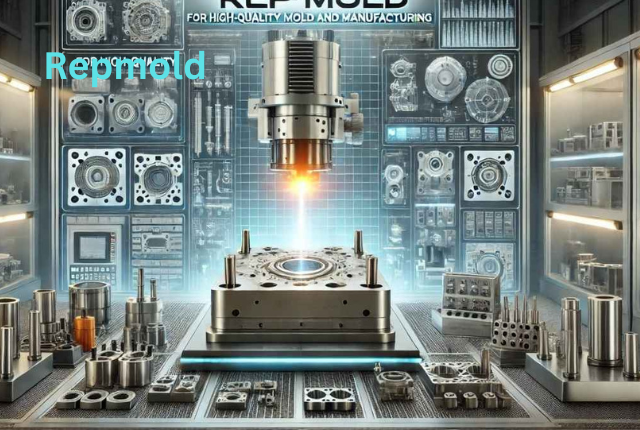Repmold The Ultimate Guide to Revolutionary Molding

The holy grail in the field of products design and production is the attainment of an impeccable repeatable form. It does not matter whether you are a large-scale manufacturer that produces thousands of parts exactly the same or a small business owner that creates personal items, the process of replication is a key to success. Here the phenomenon of repmold, or repeatability of molding, has become a game-changer. It is not merely a tool but an elaborate process that makes it consistent, less wasteful and more of a quality end product. Repmold principles are making inroads into other industries beyond automobile and aerospace sector into the art and consumer goods sector. This is step-by-step manual that will demystify the repmold process, its fundamentals, and best way to use its power.
Table of contents
Foundation Principles of Repmold
On the deepest level, repmold is not just duplication. It is a scientific method of shaping that puts an emphasis on accuracy, stability, and consistency. It is based on three major principles which distinguish this process as compared to traditional molding processes.
Material Science and Selection
The achievement of any repmold project will start with the selection of appropriate materials. This is not only on the material of the final product but also the material of the mold. The mold material should be tough enough to resist repeated use without degradation, have high dimensional stability, and be non-reactive. Rare materials used in common moulding are silicone of high quality, polyurethane and some kinds of resins. The casting substance may be plastics, metals, ceramics, and composites, each requiring casting in a specific mold type.
Precision Engineering
Master pattern and the subsequent mold is an act of precision. You need the master pattern, out of which you develop the mold, to be impeccable. Whenever the master has defects, it copies them into the rest of the copies. The technology used in modern repmold processes is often 3D printing (SLA, FDM, or SLS) to make very fine detail master pattern. This enables complicated geometries, complex designs and tight-tolerance that is impossible to attain when using manual procedures.
Parameters of the Process area
To achieve real repeatability all the steps of the molding process should be controlled. This covers temperature, pressure, time of curing and even humidity. Any alteration of temperature during the curing period may cause variation in the strength, finish or sizes of end product. High-tech repmold configurations have automated systems and sensors to keep track of these parameters so that the tenth item is exactly the same as the first.
Actionable Applications and Techniques
Repmold principles can apply to an extensive variety of industries and sizes. These techniques can customize to meet the requirements of any professional wanting to streamline a production line or any hobbyist wishing to produce high-quality outputs.
Professional and Industrial Applications of Repmold
Repmold is not merely a technique in the industrial environment, but it is a strategic benefit. It enables the companies to increase production volume and at the same time, work on the quality control at its highest limit.
Auto Manufacturing: Repmold is applicable in producing complex components of automobile interiors (e.g. dashboard components through trim components). The fit achieves perfection, and repeatability assures consistency of more than a thousand vehicles.
Aerospace and Defense: In the case of parts that cannot afford failure, the repmold is applied to create parts that have very tight tolerances. This involves prototyping to test quickly and making end use parts with high-quality materials.
Consumer Electronics: Phone cases to handcrafted keyboard keycaps, repmold makes the product have a high-quality touch and fit like a glove. The process permits development of intricate shapes and textures which promotes the user experience.
A Manufacturer’s Journey to Precision with Repmold
One of the typical problems encountered by one of the small-scaled producers of tailor-made plastic enclosures was the lack of consistency. Their conventional molding process produced parts of different sizes and different surface finishes, which increased their rate of rejection. Once they had a repmold strategy, they purchased a high-quality 3D printer to use as a master pattern and a vacuum chamber to use to de-gasp their silicone molds. They also automated their procedure and applied a digital thermometer to make sure they were using the correct curing temperatures. This saw them minimize their level of defects by 85 percent and boost their output of production by half without recruiting additional personnel. It is a practical experience of how application of repmold principles can result to huge gains of efficiency and quality improvement.
The Art and Science of DIY Repmold
You do not have to have a factory to take advantage of repmold. To artists, designers and hobbyists, these principles can enhance the quality of work and enable small scale production to exist.
Step-by-Step Guide to a Simple Repmold Project
Build Your Master: begin with the perfect master. This may be a hand-modeled object, a 3D printed object or a found object. Make sure it is clean with no flaws.
Build the Mold Box: Make a box around your master pattern. The box must not be much bigger than the master to allow the mold material room. Apply a non-stick substance or a mold release spray to make sure the mold does not stick.
Get the Mold Material: Select an excellent silicone or polyurethane. Combine the two parts thoroughly, as per the directions on the manufacturer. Have a vacuum chamber in case you have one to eliminate air bubbles, which may result in defects.
Pour and Cure: pour the mixed mold material slowly on top of your master pattern, getting down into the detail. Wait until it completely cures; this may take a few hours or even a full day, depending on the material.
Take off the Master and Cast: Be careful to remove master pattern after the cure of the mold. You now have a reusable mold! Add your casting material (e.g. resin, plaster or concrete) to the mold and allow it to cure.
De-mold and Finish: Removing the final item in the mold is challenging, do it carefully. You will have exactly a duplicate of your master. Then you can paint and polish or otherwise treat it.
Choosing the Appropriate Materials in your Project
The success depends on the selection of materials. Here’s a quick guide:
In small parts, and detailed: A silicone high-shore hardness mold should be used and a polyurethane high-speed casting.
To do on durable, heavy-duty objects: Two part epoxy resin could be cast into a hard polyurethane mold, or even concrete.
In food safe use: Add food grade silicone and food safe resin. This is essential when it comes to products such as tailor made chocolate molds or ice cube cassettes.
The Role of Technology in Modern Repmold
Repmold is more than ever before accessible and more precise due to modern technology.
3D Scanning: 3D scanners are used to reverse engineer or reproduce existing objects where every detail of an object is captured and then made into a digital form. A master pattern can then be 3D printed to be used to mold.
Computer-Aided Design (CAD) : CAD programs are computer programs that enable the designer to build intricate and flawless digital representations of components to be further employed in making flawless master patterns. This removes the aspect of manual sculpting and makes it ideal in terms of symmetry and size.
Automated Injection Molding: To take the concept of repmold further, automated injection molding devices are used when high quantities of the product are being produced. By regulating all the variables, such as the temperature of plastic, pressure of injection, etc., they produce thousands of the same units with very little human intervention.
Conclusion
Repmold is not just a method, but also a quality, consistency philosophy. You can revolutionize the manner in which you design and produce by concentrating on the principles of material science, precision engineering and process management. You could be a professional who wants to streamline a production line, or a hobbyist who wants to make flawless replicas, the principles of repmold provide an avenue to higher achievement. With these ideas, you will be able to cut down waste, save time and improve the quality of the final products. Therefore, get the first step, pick your project, and feel the strength of really repeatable molding. Beachhead of your experience in the comments below, and browse our other materials on advanced manufacturing methods, to keep moving on to precision.
FAQs
What is repmold and what is the difference between that and conventional molding?
Repmold (also known as replication molding or rapid epoxy molding) is a molding technique that produces highly accurate molds in a short amount of time with materials such as epoxy resins, typically with the assistance of CAD and 3D printing. Repmold provides repmolding of molds in hours at less than $500 unlike traditional metal molding which can require weeks and cost thousands. It is ideal to prototype or do small-scale manufacturing with flexibility available to startups or hobbyists. As an illustration, you may develop a mold supporting a custom part within a day, and it is a game-changer as far as the development time is concerned and that does not compromise the quality.
So how will repmold save money to small businesses or hobbyists?
Repmold saves money on expensive epoxy materials and the expensive machinery used is minimized. Conventional molds can cost you 10000 dollars, but repmold systems are 10 to 50 percent less than that, depending on small batch quantities. It also reduces the waste, because you can make changes on designs without having to start again. To hobbyists, it means they can make custom crafts at a cost, and to small business, it means that they can test products without having to spend huge amounts of money. To experience the savings first hand, start with a simple project, such as a phone case mold.
Is repmold appropriate to novices in manufacturing?
Repmold is without doubt newcomer-friendly as it does not demand a high level of skills and equipment. You may begin by using simple equipment such as epoxy kits and a pattern that is 3D-printed. Online tutorials, like those on Siemens’ Industry Software site, guide you through setup. It is a gentle learning process–test a small pour to learn without a lot to lose. It addresses the fear of intimidation of mold-making, allowing you to make fine reproductions, such as a personal figurine, with little practice.





